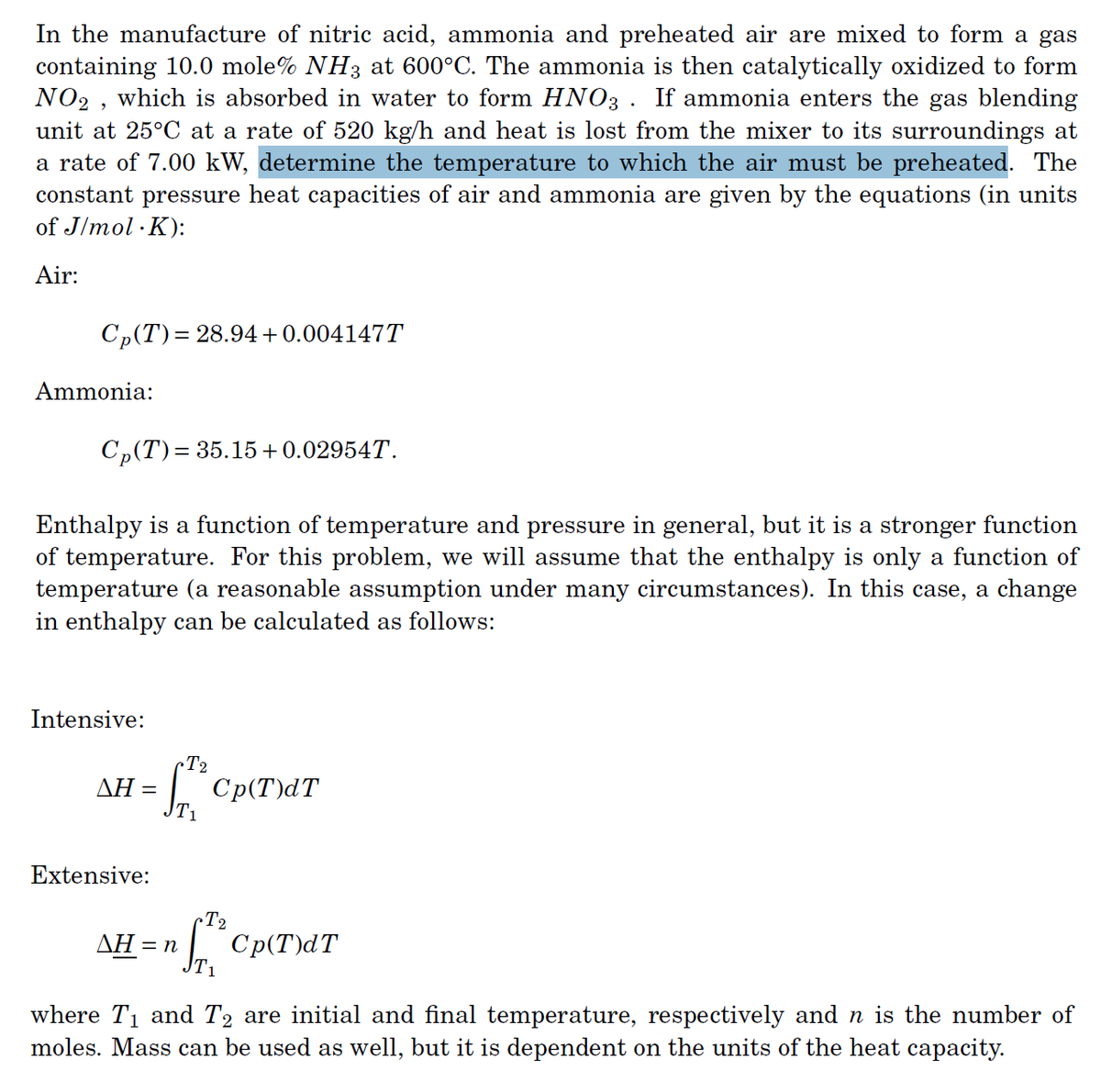In the manufacture of nitric acid, ammonia and preheated air are mixed to form a gas containing 10.0 mole% NH3 at 600°C. The ammonia is then catalytically oxidized to form NO2 , which is absorbed in water to form HNO3 . If ammonia enters the gas blending unit at 25°C at a rate of 520 kg/h and heat is lost from the mixer to its surroundings at a rate of 7.00 kW, determine the temperature to which the air must be preheated. The constant pressure heat capacities of air and ammonia are given by the equations (in units of J/mol · K): Air: Cp(T)= 28.94+0.004147T Ammonia: Cp(T)= 35.15+0.02954T. Enthalpy is a function of temperature and pressure in general, but it is a stronger function of temperature. For this problem, we will assume that the enthalpy is only a function of temperature (a reasonable assumption under many circumstances). In this case, a change in enthalpy can be calculated as follows: Intensive: •T2 L Cp(T)dT |T1 AH = Extensive: •T2 Cp(T)dT JT1 ΔΗ - = n where T1 and T2 are initial and final temperature, respectively and n is the number of moles. Mass can be used as well, but it is dependent on the units of the heat capacity.
In the manufacture of nitric acid, ammonia and preheated air are mixed to form a gas containing 10.0 mole% NH3 at 600°C. The ammonia is then catalytically oxidized to form NO2 , which is absorbed in water to form HNO3 . If ammonia enters the gas blending unit at 25°C at a rate of 520 kg/h and heat is lost from the mixer to its surroundings at a rate of 7.00 kW, determine the temperature to which the air must be preheated. The constant pressure heat capacities of air and ammonia are given by the equations (in units of J/mol · K): Air: Cp(T)= 28.94+0.004147T Ammonia: Cp(T)= 35.15+0.02954T. Enthalpy is a function of temperature and pressure in general, but it is a stronger function of temperature. For this problem, we will assume that the enthalpy is only a function of temperature (a reasonable assumption under many circumstances). In this case, a change in enthalpy can be calculated as follows: Intensive: •T2 L Cp(T)dT |T1 AH = Extensive: •T2 Cp(T)dT JT1 ΔΗ - = n where T1 and T2 are initial and final temperature, respectively and n is the number of moles. Mass can be used as well, but it is dependent on the units of the heat capacity.
Introduction to Chemical Engineering Thermodynamics
8th Edition
ISBN:9781259696527
Author:J.M. Smith Termodinamica en ingenieria quimica, Hendrick C Van Ness, Michael Abbott, Mark Swihart
Publisher:J.M. Smith Termodinamica en ingenieria quimica, Hendrick C Van Ness, Michael Abbott, Mark Swihart
Chapter1: Introduction
Section: Chapter Questions
Problem 1.1P
Related questions
Question
100%

Transcribed Image Text:In the manufacture of nitric acid, ammonia and preheated air are mixed to form a gas
containing 10.0 mole% NH3 at 600°C. The ammonia is then catalytically oxidized to form
NO2 , which is absorbed in water to form HNO3 . If ammonia enters the gas blending
unit at 25°C at a rate of 520 kg/h and heat is lost from the mixer to its surroundings at
a rate of 7.00 kW, determine the temperature to which the air must be preheated. The
constant pressure heat capacities of air and ammonia are given by the equations (in units
of J/mol · K):
Air:
Cp(T)= 28.94+0.004147T
Ammonia:
Cp(T)= 35.15+0.02954T.
Enthalpy is a function of temperature and pressure in general, but it is a stronger function
of temperature. For this problem, we will assume that the enthalpy is only a function of
temperature (a reasonable assumption under many circumstances). In this case, a change
in enthalpy can be calculated as follows:
Intensive:
•T2
L Cp(T)dT
ΔΗ
T1
Extensive:
•T2
L Cp(T)dT
T1
AH = n
where T1 and T2 are initial and final temperature, respectively and n is the number of
moles. Mass can be used as well, but it is dependent on the units of the heat capacity.
Expert Solution
This question has been solved!
Explore an expertly crafted, step-by-step solution for a thorough understanding of key concepts.
This is a popular solution!
Trending now
This is a popular solution!
Step by step
Solved in 4 steps

Knowledge Booster
Learn more about
Need a deep-dive on the concept behind this application? Look no further. Learn more about this topic, chemical-engineering and related others by exploring similar questions and additional content below.Recommended textbooks for you

Introduction to Chemical Engineering Thermodynami…
Chemical Engineering
ISBN:
9781259696527
Author:
J.M. Smith Termodinamica en ingenieria quimica, Hendrick C Van Ness, Michael Abbott, Mark Swihart
Publisher:
McGraw-Hill Education

Elementary Principles of Chemical Processes, Bind…
Chemical Engineering
ISBN:
9781118431221
Author:
Richard M. Felder, Ronald W. Rousseau, Lisa G. Bullard
Publisher:
WILEY

Elements of Chemical Reaction Engineering (5th Ed…
Chemical Engineering
ISBN:
9780133887518
Author:
H. Scott Fogler
Publisher:
Prentice Hall

Introduction to Chemical Engineering Thermodynami…
Chemical Engineering
ISBN:
9781259696527
Author:
J.M. Smith Termodinamica en ingenieria quimica, Hendrick C Van Ness, Michael Abbott, Mark Swihart
Publisher:
McGraw-Hill Education

Elementary Principles of Chemical Processes, Bind…
Chemical Engineering
ISBN:
9781118431221
Author:
Richard M. Felder, Ronald W. Rousseau, Lisa G. Bullard
Publisher:
WILEY

Elements of Chemical Reaction Engineering (5th Ed…
Chemical Engineering
ISBN:
9780133887518
Author:
H. Scott Fogler
Publisher:
Prentice Hall


Industrial Plastics: Theory and Applications
Chemical Engineering
ISBN:
9781285061238
Author:
Lokensgard, Erik
Publisher:
Delmar Cengage Learning

Unit Operations of Chemical Engineering
Chemical Engineering
ISBN:
9780072848236
Author:
Warren McCabe, Julian C. Smith, Peter Harriott
Publisher:
McGraw-Hill Companies, The